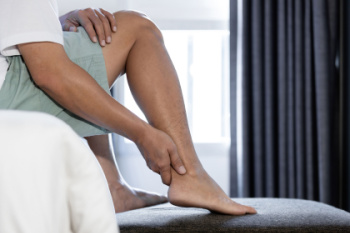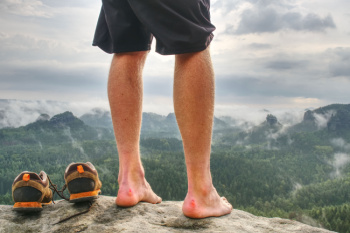
Achilles tendon injuries encompass various conditions affecting the Achilles tendon, the large tendon connecting the calf muscles to the heel bone. Tendonitis involves inflammation of the tendon due to overuse or repetitive stress, causing pain and swelling along the back of the lower leg or above the heel. Tendinosis refers to chronic degeneration of the Achilles tendon, often resulting from untreated or recurrent tendonitis. This condition may manifest as persistent pain and stiffness in the affected area. Paratenonitis affects the outer layer of the tendon, causing pain and swelling around the tendon rather than within it. Insertional Achilles tendinitis occurs at the point where the tendon inserts into the heel bone, leading to pain, swelling, and sometimes the formation of a bony bump. Treatment may involve rest, anti-inflammatory medications, custom-made orthotic devices, and in severe cases, surgical intervention to repair or remove damaged tissue. If you suffer from Achilles pain, it is suggested that you schedule an appointment with a podiatrist for a treatment plan tailored to your condition and the severity of the injury.
Achilles tendon injuries need immediate attention to avoid future complications. If you have any concerns, contact Alex Yanovskiy, DPM of Illinois Foot & Ankle Clinic. Our doctor can provide the care you need to keep you pain-free and on your feet.
What Is the Achilles Tendon?
The Achilles tendon is a tendon that connects the lower leg muscles and calf to the heel of the foot. It is the strongest tendon in the human body and is essential for making movement possible. Because this tendon is such an integral part of the body, any injuries to it can create immense difficulties and should immediately be presented to a doctor.
What Are the Symptoms of an Achilles Tendon Injury?
There are various types of injuries that can affect the Achilles tendon. The two most common injuries are Achilles tendinitis and ruptures of the tendon.
Achilles Tendinitis Symptoms
- Inflammation
- Dull to severe pain
- Increased blood flow to the tendon
- Thickening of the tendon
Rupture Symptoms
- Extreme pain and swelling in the foot
- Total immobility
Treatment and Prevention
Achilles tendon injuries are diagnosed by a thorough physical evaluation, which can include an MRI. Treatment involves rest, physical therapy, and in some cases, surgery. However, various preventative measures can be taken to avoid these injuries, such as:
- Thorough stretching of the tendon before and after exercise
- Strengthening exercises like calf raises, squats, leg curls, leg extensions, leg raises, lunges, and leg presses
If you have any questions please feel free to contact our office located in Des Plaines , IL . We offer the newest diagnostic tools and technology to treat your foot and ankle needs.
 Selecting the right running shoe involves considering several factors to ensure optimal support, comfort, and injury prevention. The first is your foot type, such as flat feet, high arches, or normal arches. You may also have a certain gait pattern, which is how your foot moves when you walk or run. Some people have feet that roll to the outside or inside, and certain shoes address this. Another consideration in choosing running shoes is the type of running you'll be doing. The right shoe should provide adequate cushioning to absorb impact, support tailored to your foot's arch type, and a comfortable fit for natural foot movement. Podiatrists can help you to understand all of the factors in this selection process. With their expertise in foot mechanics and conditions, podiatrists can perform a comprehensive evaluation of your feet to recommend shoes that match your needs. For example, they can conduct a gait analysis to recommend the right shoes for the way you walk. They can also identify any underlying issues that might affect your choice, such as pronation concerns or the need for custom orthotics. If you are in the market for new running shoes, it is suggested that you consult a podiatrist to find shoes that will maintain your foot health and optimize your running performance.
Selecting the right running shoe involves considering several factors to ensure optimal support, comfort, and injury prevention. The first is your foot type, such as flat feet, high arches, or normal arches. You may also have a certain gait pattern, which is how your foot moves when you walk or run. Some people have feet that roll to the outside or inside, and certain shoes address this. Another consideration in choosing running shoes is the type of running you'll be doing. The right shoe should provide adequate cushioning to absorb impact, support tailored to your foot's arch type, and a comfortable fit for natural foot movement. Podiatrists can help you to understand all of the factors in this selection process. With their expertise in foot mechanics and conditions, podiatrists can perform a comprehensive evaluation of your feet to recommend shoes that match your needs. For example, they can conduct a gait analysis to recommend the right shoes for the way you walk. They can also identify any underlying issues that might affect your choice, such as pronation concerns or the need for custom orthotics. If you are in the market for new running shoes, it is suggested that you consult a podiatrist to find shoes that will maintain your foot health and optimize your running performance.
You should always make sure your running shoes fit properly in order to avoid injury. For more information, contact Alex Yanovskiy, DPM from Illinois Foot & Ankle Clinic. Our doctor can provide the care you need to keep you pain-free and on your feet.
Choosing the Right Running Shoe for Your Foot Type
Improper shoe sizing can cause a myriad of problems for your feet. Shoes that don’t fit you properly can lead to muscular imbalances in your body, which can result in foot, knee, and hip injuries.
Tips for Finding the Right Running Shoe
- Make sure you have a thumb’s width of wiggle room between the end of your longest toe and the front of the shoe.
- There should be little to no slipping at the heel
- Don’t assume your size in one shoe brand will be your size in another
- Do not lace up your shoes too tightly
- Walk around in the store with your new shoes before you buy them
If you have any questions please feel free to contact our our office located in Des Plaines , IL . We offer the newest diagnostic and treatment technologies for all your foot and ankle needs.
 Blisters on the feet, though seemingly minor, can lead to more serious complications if not treated properly. These small pockets of fluid form as a result of friction or pressure, commonly from wearing ill-fitting shoes or increased physical activity. While they often heal on their own, blisters can become infected. Infections are indicated by increased pain, redness, swelling, or the presence of pus. It is important to seek medical attention if there are signs of infection, which can escalate into cellulitis, a deeper, more serious skin infection that can spread quickly. For individuals with diabetes or compromised immune systems, the risk of complications from foot blisters is significantly higher. These conditions can impair blood circulation and wound healing, making even small blisters potential gateways to severe infections. If you have a blister that is showing signs of infection, especially if a blister is not healing as expected, it is suggested that you schedule an appointment with a podiatrist as quickly as possible.
Blisters on the feet, though seemingly minor, can lead to more serious complications if not treated properly. These small pockets of fluid form as a result of friction or pressure, commonly from wearing ill-fitting shoes or increased physical activity. While they often heal on their own, blisters can become infected. Infections are indicated by increased pain, redness, swelling, or the presence of pus. It is important to seek medical attention if there are signs of infection, which can escalate into cellulitis, a deeper, more serious skin infection that can spread quickly. For individuals with diabetes or compromised immune systems, the risk of complications from foot blisters is significantly higher. These conditions can impair blood circulation and wound healing, making even small blisters potential gateways to severe infections. If you have a blister that is showing signs of infection, especially if a blister is not healing as expected, it is suggested that you schedule an appointment with a podiatrist as quickly as possible.
Blisters are prone to making everyday activities extremely uncomfortable. If your feet are hurting, contact Alex Yanovskiy, DPM of Illinois Foot & Ankle Clinic. Our doctor can provide the care you need to keep you pain-free and on your feet.
Foot Blisters
Foot blisters develop as a result of constantly wearing tight or ill-fitting footwear. This happens due to the constant rubbing from the shoe, which can often lead to pain.
What Are Foot Blisters?
A foot blister is a small fluid-filled pocket that forms on the upper-most layer of the skin. Blisters are filled with clear fluid and can lead to blood drainage or pus if the area becomes infected.
How Do Blisters Form?
Blisters on the feet are often the result of constant friction of skin and material, usually by shoe rubbing. Walking in sandals, boots, or shoes that don’t fit properly for long periods of time can result in a blister. Having consistent foot moisture and humidity can easily lead to blister formation.
Prevention & Treatment
It is important to properly care for the affected area in order to prevent infection and ease the pain. Do not lance the blister and use a Band-Aid to provide pain relief. Also, be sure to keep your feet dry and wear proper fitting shoes. If you see blood or pus in a blister, seek assistance from a podiatrist.
If you have any questions, please feel free to contact our office located in Des Plaines , IL . We offer the newest diagnostic and treatment technologies for all your foot care needs.

